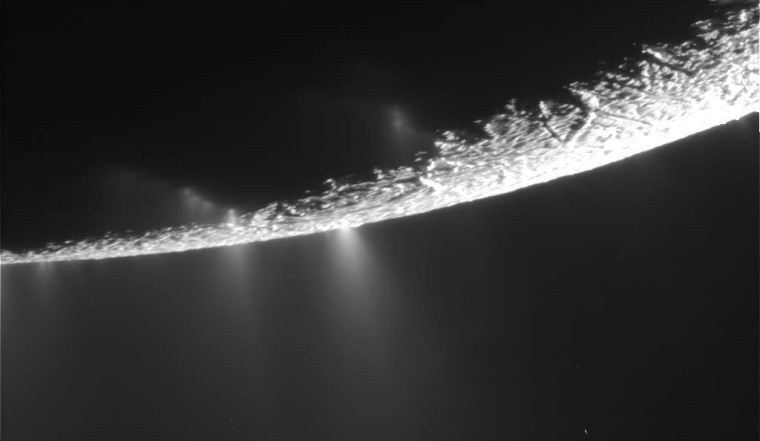Dramatic pictures sent back over the weekend from an icy moon of Saturn show water erupting into space from fissures on the surface.
The raw imagery, captured by the Cassini spacecraft on Saturday, provides a detailed look at a phenomenon that hints at the presence of a subsurface ocean on Enceladus — and perhaps life as well.
Cassini, which has been orbiting Saturn for almost five and a half years, came within 1,000 miles (1,600 kilometers) of the moon's south polar region on Saturday. The flyby afforded an opportunity for Cassini's camera to take its highest-resolution images of the fissures in that region, which have been nicknamed "tiger stripes" because of their appearance.
"These first raw images are spectacular, and paint an even more fascinating picture of Enceladus," Bob Pappalardo, Cassini project scientist at NASA's Jet Propulsion Laboratory in Pasadena, Calif., said in a mission status report. "The Cassini teams will be delving into the data to better understand the workings of this bizarre, active moon."
The leader of the Cassini imaging team, Carolyn Porco of the Colorado-based Space Science Institute, said in an e-mail that the weekend encounter was "rousingly successful."
NASA said the raw data and images from Saturday's flyby will be processed and analyzed in the coming weeks. They will help scientists create the most-detailed-yet mosaic image of the southern part of the moon's Saturn-facing hemisphere and a contiguous thermal map of one of the tiger stripes.
Scientists are particularly interested in the tiger stripes because they spew jets of water vapor and other particles hundreds of miles, from the surface. This flyby was scientists' last peek at the tiger stripes before the south pole fades into the darkness of winter for several years. The thermal imaging work focused on the tiger stripe known as Baghdad Sulcus.
Cassini is now cruising toward Rhea, another one of Saturn's moons, for more imaging and mapping work. The initial cost of the Cassini mission was $3.3 billion, with NASA, the European Space Agency and the Italian Space Agency sharing the bill. NASA extended the mission for another two years in mid-2008, at a cost of $160 million.
This report includes information from NASA. For more images from Cassini's latest flyby, visit the CICLOPS imaging team's Web site.
